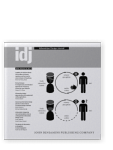Unbounded
Integrating real-world problems into an undergraduate information design course
Design courses teach a broad range of skills to prepare students for the increasingly complex and interdisciplinary situations they will face as designers. This article describes how students in a senior, capstone design course worked on a real-world project, the Communicating Pain Project, under the aegis of their university’s Center for Design in the Public Interest. The project combined case-based learning and service learning. In this article we explain how the integration of the center’s project into the classroom was accomplished, report on how it worked, and offer some thoughts on its contributions to information design pedagogy.
This article is currently available as a sample article.
References
Abendroth, L.M., & Bell, B
(Eds.) (
2016)
Public interest design practice guidebook: SEED methodology, case studies, and critical issues. New York: Routledge.

Aeschbacher, P., & Rios, M
(
2008)
Claiming public space: The case for proactive, democratic design. In
B. Bell &
K. Wakeford (Eds.),
Expanding Architecture: Design as Activism (pp. 84–91). New York: Metropolis.

Altay, B
(
2014)
User-centered design through learner-centered instruction.
Teaching in Higher Education, 19(2), 138–155.


Annerstedt, C., Garza, D., Huang-DeVoss, C., Lindh, J., & Rydmark, M
(
2010)
Research-able through problem-based learning.
Journal of the Scholarship of Teaching and Learning, 10(2), 107–127.

Baeten, M., Dochy, F., & Struyven, K
(
2013)
The effects of different learning environments on students’ motivation for learning and their achievement.
British Journal of Educational Psychology, 831, 484–501.


Blair-Early, A
(
2010)
Beyond borders: Participatory design research and the changing role of design.
Visible Language, 44(2), 207–218.

Bourelle, T
(
2012)
Bridging the gap between the technical communication classroom and the internship: Teaching social consciousness and real-world writing.
Journal of Technical Writing and Communication, 42(2), 183–197.


Butcher, J., & Schaber, F
(
2013)
Undergraduate design learningin multiple partnerships: joinedupdesign for academies.
International Journal of Technology & Design Education, 231, 567–579.


Dorst, K
(
2011)
The core of ‘design thinking’ and its application.
Design Studies, 321, 521–532.


Fisher, T
(
2016)
Professional responsibility and ethics. In
L.M. Abendroth &
B. Bell (Eds.),
Public interest design practice guidebook: SEED methodology, case studies, and critical issues (pp. 35–44). New York: Routledge.

Fishman, S.M
(
2012)
Listening to pain: A clinician’s guide to improving pain management through better communication. Oxford: Oxford University Press.

Forsyth, A., Lu, H., & McGirr, P
(
2000)
Service learning in an urban context: Implications for planning and design education.
Journal of Architecture and Planning Research, 17(3), 236–259.

Gerstner, K
(
1974)
Compendium for literates: a system of writing. The MIT Press.

Hasrati, M
(
2005)
Legitimate peripheral participation and supervising Ph.D. students.
Studies in Higher Education, 30(5), 557–570.


Huckin, T
(
1997)
Technical writing and community service.
Journal of Business and Technical Communication, 11(1), 49–59.


IDEO Product Development
(
2003)
IDEO Method Cards: 51 Ways to Inspire Design. Palo Alto: IDEO.

Institute of Medicine
. Committee on Advancing Pain Research, Care, and Education (
2011)
Relieving pain in America: A blueprint for transforming prevention, care, education, and research. Washington, D.C.: National Academy of Sciences.

Jang, A., MacLean, D., & Heer, J
(
2013)
Designing a prototype interface for visual communication of pain. Paper presented at the
CHI’13 Extended Abstracts on Human Factors in Computing Systems
.

Kolko, J
(
2011)
Thoughts on interaction design: A collection of reflections. Amsterdam: Elsevier/Morgan Kaufmann.

Lee, N
(
2009)
Project methods as the vehicle for learning iundergraduate design education: A typology.
Design Studies, 301, 541–560.


Melzack, R., & Torgerson, W.S
(
1971)
On the language of pain.
Anesthesiology, 34(1), 50–59.


National Academies Press. Institute of Medicine Reportfrom the Committee on Advancing Pain Research, Care, and Education
(
2011)
Relieving Pain in America, A Blueprint for Transforming Prevention, Care, Education and Research.
The National Academies Press. Retrieved September 2, 2016, from
[URL].

National Center on Universal Design for Learning
(
2014)
Case-based learning. Retrieved June 11, 2016, from
[URL].
Partners Against Pain
(
2016)
Memorial pain assessment card. Retrieved June 14, 2016, from
[URL]
Pentland, A.S
(
2012)
The new science of building great teams.
Harvard Business Review, April 2012, 60–70.

Riley, L.A., Wojahn, P., & Park, Y.H
(
2003)
Multidisciplinary courses: Facilitating win-win opportunities across departments and colleges. Online Proceedings of the
2003 Science,Engineering, and Technology Education Conference
, 1–10.
Steinke, P., & Fitch, P
(
2014)
Using goal-based learning to understand why service-learning improves cognitive outcomes.
Currents in Teaching and Learning, 7(1), 50–63.

Tharp, Twyla
(
2003)
The Creative Habit: Learn it and Use it for Life. New York: Simon & Schuster.

Verba, S
(
2014)
DES 159: Design for Understanding. [Syllabus]. Department of Design, University of California, Davis, Davis, CA.

Cited by
Cited by 2 other publications
Judge, Pamela K., Jane A. Buxton, Thomas C. Sheahan, Eleanor R. Phetteplace, David L. Kriebel & Elisabeth M. Hamin Infield
2020.
Teaching across disciplines: a case study of a project-based short course to teach holistic coastal adaptation design.
Journal of Environmental Studies and Sciences 10:3
► pp. 341 ff.

Waller, Robert & Stephanie VandenBerg
This list is based on CrossRef data as of 31 march 2024. Please note that it may not be complete. Sources presented here have been supplied by the respective publishers.
Any errors therein should be reported to them.
